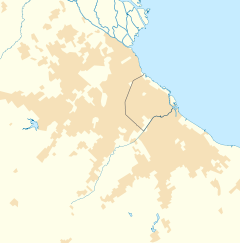San Antonio de Padua | |
|---|---|
 The Church of San Antonio de Padua during the July 9, 2007 snowstorm, the first in the Buenos Aires area since 1918. | |
Location in Greater Buenos Aires | |
| Coordinates: 34°40′S 58°42′W / 34.667°S 58.700°W | |
| Country | |
| Province | |
| Partido | Merlo |
| Elevation | 20 m (70 ft) |
| Population | |
| • Total | 37,775 |
| • Density | 6,039.2/km2 (15,641/sq mi) |
| CPA Base | B 1718 |
| Area code | +54 220 |
San Antonio de Padua, or plainly Padua, is a city in the Greater Buenos Aires, in Argentina. It is located in Merlo Partido. The city has an area of 6.25 km2 (2 sq mi) and a population of around 38,000.
The name commemorates the village founded by Francisco de Merlo, Villa San Antonio del Camino in 1755, named for the Portuguese saint Anthony of Padua. The city is on one of the major rail and road arteries and is well connected to the most important cities of the western Greater Buenos Aires.
Padua is bordered by the partido of Ituzaingó (north and east), other localidades of Merlo (west and southwest) and Libertad (south).
Padua is basically a flat, low-rise city, with few buildings over two stories, so the skyline is still dominated by the spire of the Church of San Antonio de Padua. The building emerges in the center of a peaceful middle-class neighborhood of white-painted and red-barrel-tiles-roofed houses. The church was inaugurated in 1931 and few years later a Franciscan monastery and a catholic school were erected at its side. The church was built in a Romanesque style and is one of the Padua's landmark buildings.
The commercial center is around the main avenue, Avenida Noguera, stretching six blocks from the railroad station, Estación San Antonio de Padua to the east.
The city status was conferred on September 11, 1974 by the Buenos Aires (Province) Legislature.

